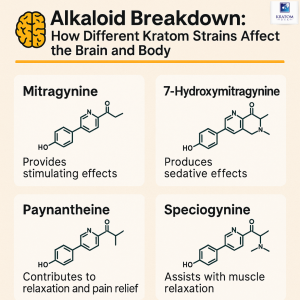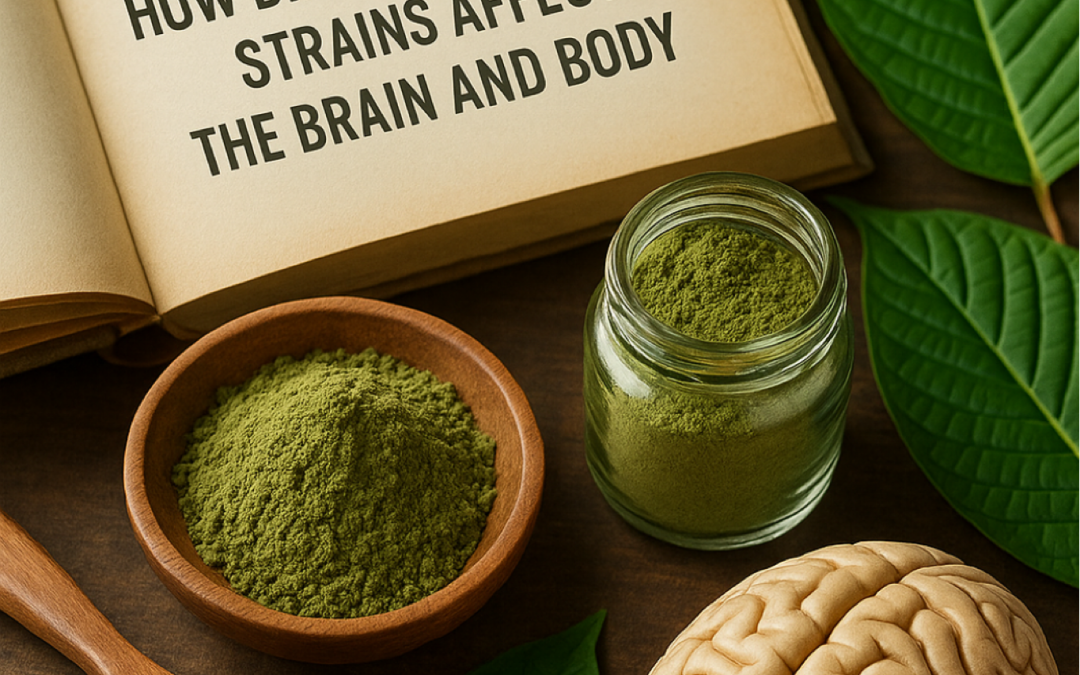🔬 How Different Kratom Strains Affect the Brain and Body: Alkaloid Breakdown
Whether you’re a kratom veteran or a curious beginner, this guide offers the scientific insight you need to know how different kratom strains affect the brain and body.
Kratom (Mitragyna speciosa) has been praised for its ability to provide energy, relief, relaxation, and focus—but did you know these effects are the result of specific alkaloids interacting with your body’s receptors?
The key to understanding why some kratom strains energize you while others put you to sleep lies in their alkaloid profiles—the natural compounds in kratom leaves that shape its effects. In this article, we’ll explore how major alkaloids like mitragynine, 7-hydroxymitragynine, paynantheine, and speciogynine work—and how their concentrations vary between strains.
📌 Key Points: Kratom Alkaloids and Strain Effects
-
🧪 Mitragynine and 7-hydroxymitragynine are the two most active alkaloids in kratom.
-
🌿 Alkaloid concentrations vary between white, green, and red strains.
-
⚡ High mitragynine = more stimulation (found in white strains).
-
😌 Higher 7-hydroxymitragynine = more sedation and pain relief (found in reds).
-
🧠 Minor alkaloids like paynantheine and speciogynine support muscle relaxation and mood balance.
-
🧬 The strain’s origin, drying process, and fermentation also impact alkaloid content.
🧠 What Are Kratom Alkaloids?
 Alkaloids are naturally occurring chemical compounds found in plants that affect human physiology. In kratom, the two most abundant alkaloids—mitragynine and 7-hydroxymitragynine—interact with mu-opioid, adrenergic, and serotonin receptors to produce a variety of effects.
Alkaloids are naturally occurring chemical compounds found in plants that affect human physiology. In kratom, the two most abundant alkaloids—mitragynine and 7-hydroxymitragynine—interact with mu-opioid, adrenergic, and serotonin receptors to produce a variety of effects.
Kratom contains over 40 identified alkaloids, but here are the four most important ones:
🧪 1. Mitragynine: The Primary Energizer
-
Found in high amounts (up to 66%) in most kratom leaves
-
Acts on opioid and adrenergic receptors
-
Associated with energy, alertness, motivation, and mild pain relief
Common in:
-
Maeng Da
-
White Thai
-
Green Malay
Keywords: kratom mitragynine, stimulating kratom strains
🧬 A 2018 study in Frontiers in Psychiatry found mitragynine to be the most prevalent alkaloid and a partial agonist of opioid receptors, producing less respiratory depression than classical opioids.
🛌 2. 7-Hydroxymitragynine: The Potent Sedative
-
Present in much smaller quantities (~0.01%–0.04%), but very strong
-
Binds strongly to mu-opioid receptors
-
Known for sedation, euphoria, and powerful pain relief
Common in:
-
Gold Kratom (for enhanced sedation)
Keywords: 7-hydroxymitragynine effects, kratom for pain relief
🧪 Research published in The Journal of Medicinal Chemistry confirms that 7-hydroxymitragynine is 46x more potent than mitragynine at mu-opioid receptors.
💪 3. Paynantheine: The Muscle Relaxant
-
Second most abundant alkaloid after mitragynine
-
Primarily a muscle relaxant with mild sedative effects
-
May help with anxiety and tension-related pain
Common in:
-
Green strains
-
Red Borneo
Keywords: kratom for muscle relaxation, paynantheine benefits
🧬 Its non-opioid mechanisms make it a good candidate for muscle recovery without the risk of strong sedation.
😌 4. Speciogynine: The Mood Balancer
-
Third most prevalent alkaloid in kratom
-
Has mild sedative and muscle-relaxing effects
-
May promote calm and emotional clarity
Common in:
-
Red Bali
-
Green Malay
Keywords: speciogynine kratom, kratom for anxiety
🌿 How Alkaloid Profiles Vary by Strain
Each kratom strain contains a unique ratio of alkaloids, which directly affects how you feel after taking it.
| Strain Type | Alkaloid Dominance | Typical Effects |
|---|---|---|
| White Vein | High mitragynine | Energy, focus, motivation |
| Green Vein | Balanced mix of alkaloids | Mild energy, mood boost, mental clarity |
| Red Vein | Higher 7-hydroxymitragynine | Sedation, pain relief, muscle relaxation |
| Gold | Enhanced via fermentation | Extra sedation and calming effects |
💡 Drying and fermentation processes can also change alkaloid content.
🔄 What Else Affects Alkaloid Levels?
-
Harvest time (older leaves tend to have more sedative alkaloids)
-
Climate and soil (terroir can impact potency)
-
Drying method (sun-dried vs indoor-dried changes chemistry)
-
Fermentation (used in Bentuangie and Gold strains to increase 7-hydroxymitragynine)
🛒 Choosing the Right Strain Based on Alkaloid Goals
If your goal is to:
-
Stay focused and energized 👉 go for Green Malay
-
Relieve pain and relax 👉 try Red Bali
-
Find balance 👉 choose Green Maeng Da
-
Ease muscle tension 👉 try Red Borneo
🔎 Always buy from lab-tested vendors like Kratom USA to ensure accurate alkaloid content and safety.
❓ FAQ: Kratom Alkaloids and Effects
Which kratom alkaloid is most stimulating?
Mitragynine—especially in white vein strains—is responsible for energy and alertness.
Which alkaloid makes kratom sedating?
7-hydroxymitragynine is the key compound behind kratom’s sedative and pain-relieving effects.
Do all strains have the same alkaloid content?
No. Alkaloid profiles vary by strain, origin, and processing method, which is why effects differ.
Can kratom alkaloid content be tested?
Yes—reputable vendors provide COAs (Certificates of Analysis) that list alkaloid concentrations.
What’s the best kratom strain if I want both clarity and calm?
Green Maeng Da or Green Malay offer a balanced alkaloid profile for focus without overstimulation.
🧬 Final Thoughts: Why Alkaloid Profiles Matter in Kratom
The power of kratom lies in its diverse alkaloid makeup—each strain delivering a different experience based on its unique chemistry. Whether you’re seeking focus, pain relief, or calm, understanding kratom’s alkaloid structure can help you make smarter, safer choices.
By choosing the right strain, dose, and source, you’ll be able to unlock kratom’s full potential—and avoid confusion or unwanted effects.


